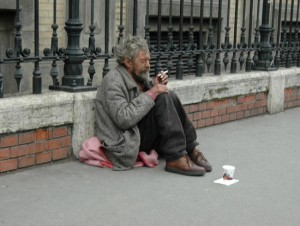Homelessness in Washington, D.C. has increased by 12.9 percent in the past year. In Memphis, Tennessee, nearly half the demand for emergency food assistance in 2013 has gone unmet. The number of requests for urgent food aid in Philadelphia rose by 20 percent. And in Plano, Texas, homeless shelters with limited capacity were forced to turn away 84 percent of those seeking help.
These statistics come from the U.S. Conference of Mayors’ 2014 Hunger and Homelessness Survey, a report compiled with the participation of 25 city governments around the country. The annual survey does not offer a representative sample of nationwide trends, but it does provide a narrow glimpse of how those trends affect a handful of large municipalities scattered across various regions.
Overall, 71 percent of participating cities reported an increase in local demand for emergency food assistance between September 2013 and August 2014, and 43 percent of those cities reported an increase in homelessness. Across all cities, homelessness was found to have risen 0.7 percent, and need for food assistance was found to have gone up 7 percent.
Low wages were cited as a key reason for increasing food insecurity, while city governments identified a lack of affordable housing as the main challenge when it comes to fighting homelessness. Some 38 percent of those requesting emergency food assistance were employed at the time, and 18 percent of the cities’ homeless population had jobs.
“There are still too many unemployed workers in our cities, and this continues to add to the stress on emergency assistance programs,” said U.S. Conference of Mayors CEO Tom Cochran during a Thursday conference call.
Nationwide, poverty and homelessness have declined over the past few years as the United States has straggled out of recession. However, the National Center on Family Homelessness reports that child homelessness is at an all-time high as of 2013.
Food insecurity in the U.S. spiked precipitously between 2007 and 2008, but the Department of Agriculture (USDA) has observed a very slight decrease from its post-recession peak between 2011 and 2013. However, the USDA’s latest figures don’t gauge the impact of recent cuts to food stamps, which began in November 2013. Food banks across the U.S. are currently reporting an unprecedented demand for emergency food services.
Santa Barbara Mayor Helene Schneider said mayors in most of the surveyed cities feared that they would soon have even fewer resources for providing emergency assistance.
“Until our economy improves for all Americans, programs to combat hunger, poverty, and homelessness need to be protected, not compromised, by this Congress,” she said.
One bright spot in the survey was a sharp decline in veteran homelessness. Between 2013 and 2014, the population of veterans who are homeless dropped by 10 percent in the surveyed municipalities. The Department of Housing and Urban Development (HUD) reports that veteran homelessness nationwide has declined by a third since 2010, and the department hopes to virtually eradicate it by 2015.
“Homelessness is not an intractable problem,” said Richard Cho, senior policy director at the federal Interagency Council on Homelessness, during Thursday’s call. “It’s a problem we know how to solve.”










